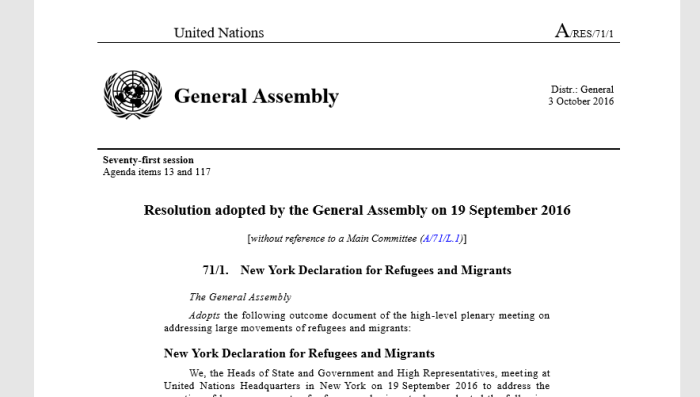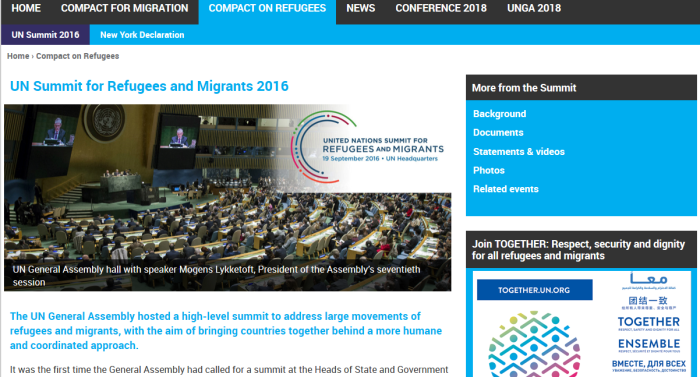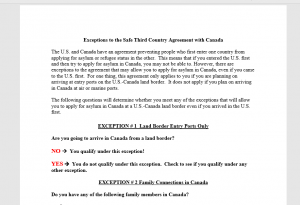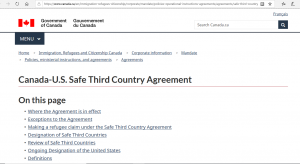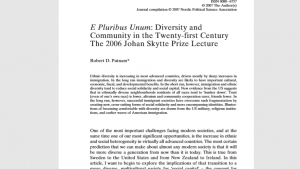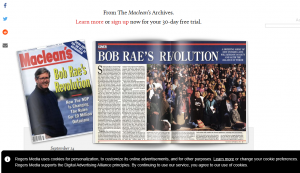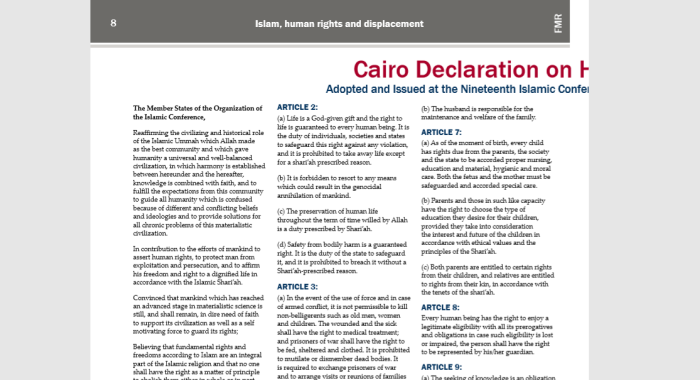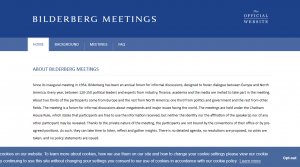
1. Important Links
CLICK HERE, for the main page.
CLICK HERE, for the FAQ section.
CLICK HERE, for the “Participants” section.
CLICK HERE, for then Immigration Minister Jason Kenney attending in 2014.
2. 2018 Bilderberg Meetings
Turin, Italy 7-10 June 2018
CHAIRMAN STEERING COMMITTEE
Castries, Henri de (FRA), Chairman, Institut Montaigne
PARTICIPANTS
Achleitner, Paul M. (DEU), Chairman Supervisory Board, Deutsche Bank AG; Treasurer, Foundation Bilderberg Meetings
Agius, Marcus (GBR), Chairman, PA Consulting Group
Alesina, Alberto (ITA), Nathaniel Ropes Professor of Economics, Harvard University
Altman, Roger C. (USA), Founder and Senior Chairman, Evercore
Amorim, Paula (PRT), Chairman, Américo Amorim Group
Anglade, Dominique (CAN), Deputy Premier of Quebec; Minister of Economy, Science and Innovation
Applebaum, Anne (POL), Columnist, Washington Post; Professor of Practice, London School of Economics
Azoulay, Audrey (INT), Director-General, UNESCO
Baker, James H. (USA), Director, Office of Net Assessment, Office of the Secretary of Defense
Barbizet, Patricia (FRA), President, Temaris & Associés
Barroso, José M. Durão (PRT), Chairman, Goldman Sachs International; Former President, European Commission
Beerli, Christine (CHE), Former Vice-President, International Committee of the Red Cross
Berx, Cathy (BEL), Governor, Province of Antwerp
Beurden, Ben van (NLD), CEO, Royal Dutch Shell plc
Blanquer, Jean-Michel (FRA), Minister of National Education, Youth and Community Life
Botín, Ana P. (ESP), Group Executive Chairman, Banco Santander
Bouverot, Anne (FRA), Board Member; Former CEO, Morpho
Brandtzæg, Svein Richard (NOR), President and CEO, Norsk Hydro ASA
Brende, Børge (INT), President, World Economic Forum
Brennan, Eamonn (IRL), Director General, Eurocontrol
Brnabic, Ana (SRB), Prime Minister
Burns, William J. (USA), President, Carnegie Endowment for International Peace
Burwell, Sylvia M. (USA), President, American University
Caracciolo, Lucio (ITA), Editor-in-Chief, Limes
Carney, Mark J. (GBR), Governor, Bank of England
Castries, Henri de (FRA), Chairman, Institut Montaigne; Chairman, Steering Committee Bilderberg Meetings
Cattaneo, Elena (ITA), Director, Laboratory of Stem Cell Biology, University of Milan
Cazeneuve, Bernard (FRA), Partner, August Debouzy; Former Prime Minister
Cebrián, Juan Luis (ESP), Executive Chairman, El País
Champagne, François-Philippe (CAN), Minister of International Trade
Cohen, Jared (USA), Founder and CEO, Jigsaw at Alphabet Inc.
Colao, Vittorio (ITA), CEO, Vodafone Group
Cook, Charles (USA), Political Analyst, The Cook Political Report
Dagdeviren, Canan (TUR), Assistant Professor, MIT Media Lab
Donohoe, Paschal (IRL), Minister for Finance, Public Expenditure and Reform
Döpfner, Mathias (DEU), Chairman and CEO, Axel Springer SE
Ecker, Andrea (AUT), Secretary General, Office Federal President of Austria
Elkann, John (ITA), Chairman, Fiat Chrysler Automobiles
Émié, Bernard (FRA), Director General, Ministry of the Armed Forces
Enders, Thomas (DEU), CEO, Airbus SE
Fallows, James (USA), Writer and Journalist
Ferguson, Jr., Roger W. (USA), President and CEO, TIAA
Ferguson, Niall (USA), Milbank Family Senior Fellow, Hoover Institution, Stanford University
Fischer, Stanley (USA), Former Vice-Chairman, Federal Reserve; Former Governor, Bank of Israel
Gilvary, Brian (GBR), Group CFO, BP plc
Goldstein, Rebecca (USA), Visiting Professor, New York University
Gruber, Lilli (ITA), Editor-in-Chief and Anchor “Otto e mezzo”, La7 TV
Hajdarowicz, Greg (POL), Founder and President, Gremi International Sarl
Halberstadt, Victor (NLD), Professor of Economics, Leiden University; Chairman Foundation Bilderberg Meetings
Hassabis, Demis (GBR), Co-Founder and CEO, DeepMind
Hedegaard, Connie (DNK), Chair, KR Foundation; Former European Commissioner
Helgesen, Vidar (NOR), Ambassador for the Ocean
Herlin, Antti (FIN), Chairman, KONE Corporation
Hickenlooper, John (USA), Governor of Colorado
Hobson, Mellody (USA), President, Ariel Investments LLC
Hodgson, Christine (GBR), Chairman, Capgemini UK plc
Hoffman, Reid (USA), Co-Founder, LinkedIn; Partner, Greylock Partners
Horowitz, Michael C. (USA), Professor of Political Science, University of Pennsylvania
Hwang, Tim (USA), Director, Harvard-MIT Ethics and Governance of AI Initiative
Ischinger, Wolfgang (INT), Chairman, Munich Security Conference
Jacobs, Kenneth M. (USA), Chairman and CEO, Lazard
Kaag, Sigrid (NLD), Minister for Foreign Trade and Development Cooperation
Karp, Alex (USA), CEO, Palantir Technologies
Kissinger, Henry A. (USA), Chairman, Kissinger Associates Inc.
Knot, Klaas H.W. (NLD), President, De Nederlandsche Bank
Koç, Ömer M. (TUR), Chairman, Koç Holding A.S.
Köcher, Renate (DEU), Managing Director, Allensbach Institute for Public Opinion Research
Kotkin, Stephen (USA), Professor in History and International Affairs, Princeton University
Kragic, Danica (SWE), Professor, School of Computer Science and Communication, KTH
Kravis, Henry R. (USA), Co-Chairman and Co-CEO, KKR
Kravis, Marie-Josée (USA), Senior Fellow, Hudson Institute; President, American Friends of Bilderberg
Kudelski, André (CHE), Chairman and CEO, Kudelski Group
Lepomäki, Elina (FIN), MP, National Coalition Party
Leyen, Ursula von der (DEU), Federal Minster of Defence
Leysen, Thomas (BEL), Chairman, KBC Group
Makan, Divesh (USA), CEO, ICONIQ Capital
Massolo, Giampiero (ITA), Chairman, Fincantieri Spa.; President, ISPI
Mazzucato, Mariana (ITA), Professor in the Economics of Innovation and Public Value, University College London
Mead, Walter Russell (USA), Distinguished Fellow, Hudson Institute
Michel, Charles (BEL), Prime Minister
Micklethwait, John (USA), Editor-in-Chief, Bloomberg LP
Minton Beddoes, Zanny (GBR), Editor-in-Chief, The Economist
Mitsotakis, Kyriakos (GRC), President, New Democracy Party
Mota, Isabel (PRT), President, Calouste Gulbenkian Foundation
Moyo, Dambisa F. (USA), Global Economist and Author
Mundie, Craig J. (USA), President, Mundie & Associates
Neven, Hartmut (USA), Director of Engineering, Google Inc.
Noonan, Peggy (USA), Author and Columnist, The Wall Street Journal
Oettinger, Günther H. (INT), Commissioner for Budget & Human Resources, European Commission
O’Leary, Michael (IRL), CEO, Ryanair D.A.C.
O’Neill, Onora (GBR), Emeritus Honorary Professor in Philosophy, University of Cambridge
Osborne, George (GBR), Editor, London Evening Standard
Özkan, Behlül (TUR), Associate Professor in International Relations, Marmara University
Papalexopoulos, Dimitri (GRC), CEO, Titan Cement Company S.A.
Parolin, H.E. Pietro (VAT), Cardinal and Secretary of State
Patino, Bruno (FRA), Chief Content Officer, Arte France TV
Petraeus, David H. (USA), Chairman, KKR Global Institute
Pichette, Patrick (CAN), General Partner, iNovia Capital
Pouyanné, Patrick (FRA), Chairman and CEO, Total S.A.
Pring, Benjamin (USA), Co-Founder and Managing Director, Center for the Future of Work
Rankka, Maria (SWE), CEO, Stockholm Chamber of Commerce
Ratas, Jüri (EST), Prime Minister
Rendi-Wagner, Pamela (AUT), MP (SPÖ); Former Minister of Health
Rivera Díaz, Albert (ESP), President, Ciudadanos Party
Rossi, Salvatore (ITA), Senior Deputy Governor, Bank of Italy
Rubesa, Baiba A. (LVA), CEO, RB Rail AS
Rubin, Robert E. (USA), Co-Chairman Emeritus, Council on Foreign Relations; Former Treasury Secretary
Rudd, Amber (GBR), MP; Former Secretary of State, Home Department
Rutte, Mark (NLD), Prime Minister
Sabia, Michael (CAN), President and CEO, Caisse de dépôt et placement du Québec
Sadjadpour, Karim (USA), Senior Fellow, Carnegie Endowment for International Peace
Sáenz de Santamaría, Soraya (ESP), Deputy Prime Minister
Sawers, John (GBR), Chairman and Partner, Macro Advisory Partners
Schadlow, Nadia (USA), Former Deputy National Security Advisor for Strategy
Schneider-Ammann, Johann N. (CHE), Federal Councillor
Scholten, Rudolf (AUT), President, Bruno Kreisky Forum for International Dialogue
Sikorski, Radoslaw (POL), Senior Fellow, Harvard University; Former Minister of Foreign Affairs, Poland
Simsek, Mehmet (TUR), Deputy Prime Minister
Skartveit, Hanne (NOR), Political Editor, Verdens Gang
Stoltenberg, Jens (INT), Secretary General, NATO
Summers, Lawrence H. (USA), Charles W. Eliot University Professor, Harvard University
Thiel, Peter (USA), President, Thiel Capital
Topsøe, Jakob Haldor (DNK), Chairman, Haldor Topsøe Holding A/S
Turpin, Matthew (USA), Director for China, National Security Council
Wahlroos, Björn (FIN), Chairman, Sampo Group, Nordea Bank, UPM-Kymmene Corporation
Wallenberg, Marcus (SWE), Chairman, Skandinaviska Enskilda Banken AB
Woods, Ngaire (GBR), Dean, Blavatnik School of Government, Oxford University
Yetkin, Murat (TUR), Editor-in-chief, Hürriyet Daily News
Zeiler, Gerhard (AUT), President, Turner International
As should be obvious from the list, a lot of banks and investment holding companies are represented. Why would that be? Are there some big profits to be made in all this?
3. Brief History
The Bilderberg meeting is an annual three-day forum for informal discussions designed to foster dialogue between Europe and North America. The pioneering meeting grew out of the concern, expressed by leading citizens on both sides of the Atlantic, that Western Europe and North America were not working together as closely as they should on issues of common interest.
The first meeting took place in Hotel De Bilderberg in Oosterbeek, Netherlands, from 29 to 31 May 1954. Representatives from economic, social, political and cultural fields were invited to hold informal discussions to help create a better understanding of the complex forces and major trends affecting Western nations in the difficult post-war period.
Throughout the years, the annual meetings have become a forum for discussion on a wide range of topics – from trade to jobs, from monetary policy to investment and from ecological challenges to the task of promoting international security. In the context of a globalised world, it is hard to think of any issue in either Europe or North America that could be tackled unilaterally.
4. Steering Committee
CHAIRMAN
Castries, Henri de (FRA), Chairman, Institut Montaigne
Achleitner, Paul M. (DEU), Chairman Supervisory Board, Deutsche Bank AG; Treasurer, Foundation Bilderberg Meetings
Altman, Roger C. (USA), Founder and Senior Chairman, Evercore
Barbizet, Patricia (FRA), President, Temaris & Associés
Barroso, José M. Durão (PRT), Chairman, Goldman Sachs International; Former President, European Commission
Botín, Ana P. (ESP), Group Executive Chairman, Banco Santander
Brandtzæg, Svein Richard (NOR), President and CEO, Norsk Hydro ASA
Döpfner, Mathias (DEU), Chairman and CEO, Axel Springer SE
Elkann, John (ITA), Chairman, Fiat Chrysler Automobiles
Gruber, Lilli (ITA), Editor-in-Chief and Anchor “Otto e mezzo”, La7 TV
Halberstadt, Victor (NLD), Professor of Economics, Leiden University; Chairman Foundation Bilderberg Meetings
Hedegaard, Connie (DNK), Chair, KR Foundation; Former European Commissioner
Hobson, Mellody (USA), President, Ariel Investments LLC
Karp, Alex (USA), CEO, Palantir Technologies
Koç, Ömer M. (TUR), Chairman, Koç Holding A.S.
Kravis, Marie-Josée (USA), Senior Fellow, Hudson Institute; President, American Friends of Bilderberg Inc.
Kudelski, André (CHE), Chairman and CEO, Kudelski Group
Leysen, Thomas (BEL), Chairman, KBC Group
Micklethwait, John (USA), Editor-in-Chief, Bloomberg LP
Minton Beddoes, Zanny (GBR), Editor-in-Chief, The Economist
Mundie, Craig J. (USA), President, Mundie & Associates
O’Leary, Michael (IRL), CEO, Ryanair D.A.C.
Papalexopoulos, Dimitri (GRC), CEO, Titan Cement Company S.A.
Sabia, Michael (CAN), President and CEO, Caisse de dépôt et placement du Québec
Sawers, John (GBR), Chairman and Partner, Macro Advisory Partners
Schadlow, Nadia (USA), Senior Fellow, Hudson Institute
Schmidt, Eric E. (USA), Technical Advisor, Alphabet Inc.
Scholten, Rudolf (AUT), President, Bruno Kreisky Forum for International Dialogue
Sikorski, Radoslaw (POL), Senior Fellow, Harvard University; Former Minister of Foreign Affairs, Poland
Thiel, Peter (USA), President, Thiel Capital
Wallenberg, Marcus (SWE), Chairman, Skandinaviska Enskilda Banken AB
5. Bilderberg Goals
What are the Bilderberg Meetings and what are its goals?
The Bilderberg Meeting is an annual meeting designed to foster dialogue between Europe and North America. Bilderberg was established in 1954 as a forum for informal discussions, bringing together individuals who share an active interest in affairs relevant to the relationship between Europe and Northern America. The meeting has one main goal: to foster discussion and dialogue. There is no desired outcome, there is no closing statement, there are no resolutions proposed or votes taken.
Sounds so harmless and innocuous.
But then, it always does.


